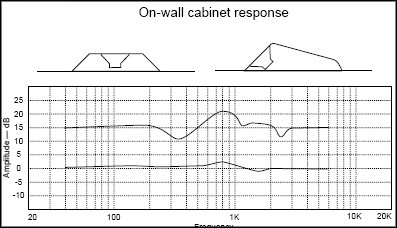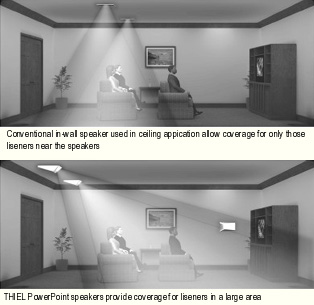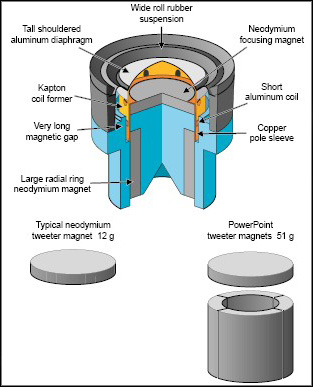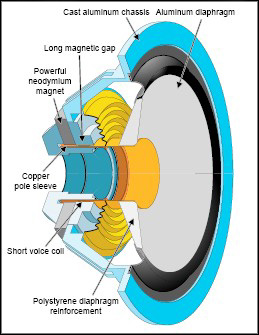Improved Frequency Response From 450
Driver Mounting Angle
A conventional wall mount speaker has the woofer
parallel to the mounting surface. This tends to create anomalies in the
frequency response due to cancellations from wall reflections. In
comparison, the PP1.2 utilizes a 450 driver mounting angle. This
keeps the woofer much closer to the mounting surface, and ensures that all
frequencies in the woofer’s pass band remain within ˝ wavelength of the wall
mounting surface. This tends to minimize the effect that wall reflections
will have on the frequency response.
Provided below is a diagram illustrating these differences. The top curve
shows the FR anomalies typically associated with the conventional wall mount
design. The bottom curve shows the reduction of these anomalies achieved
with the PP1.2 450 mounting angle design.

Improved Dispersion From 45 Degree Driver
Mounting Angle
Compared to a conventional 900 wall-mount
design, the PP1.2 450 mounting angle greatly improves the in-room
dispersion pattern, providing more coverage for more listeners in the room.
Some 900 on-wall designs use a rotating tweeter to overcome this
limitation, but that often results in diffraction problems, and the PP1.2
design is ultimately a much more elegant solution to achieving an optimal
in-room dispersion pattern.
Provided below is an illustration showing the
limited dispersion pattern of a typical 900 wall-mount design
verses the improved dispersion pattern of the Thiel 450
wall-mount design.

The PP1.2 tweeter is the same unit used in the
famous Thiel flagship the CS7.2. Salient features of this tweeter design
include:
- An aluminum cone with a wide-roll rubber suspension.
- High output and low distortion afforded by a 5 mm magnetic gap, and a
remarkable 3 mm linear peak-to-peak excursion.
- A large, rare-earth (neodymium) ring-shaped magnet used to magnetize the
gap, and a second disc-shaped neodymium focusing magnet used above the gap.
Total magnet weight is 51 grams, which is much higher than the typical
tweeter.
- A high thermal capacity aluminum voice coil wrapped around a Kapton
former.
- A copper sleeve used around the pole to improve the stability of the
magnetic field and reduce voice coil inductance, thereby reducing distortion
and improving high frequency response.
 The
PP1.2 woofer design features include:
The
PP1.2 woofer design features include:
- An aluminum cone with polystyrene reinforcement for increased rigidity, a
wide-roll rubber surround, and single spider suspension.
- A cast aluminum basket for strength and minimal resonances.
- A powerful rare-earth (neodymium) magnet which provides ten times the
field strength of a normal ferrite magnet, and so can be much smaller, allowing
the use of a shallow enclosure design.
- A high thermal capacity voice coil wrapped around a Kapton former.
- A copper sleeve used around the pole to improve the stability of the
magnetic field and reduce voice coil inductance, thereby reducing distortion
and improving midrange frequency response, allowing a smooth transition to
the tweeter.
The PP1.2 has rated bass extension frequency of 75 Hz (-3 dB). Since the
PP1.2 is a sealed loudspeaker, it will roll-off below 75 Hz with a 2nd order
slope (12 dB/octave). Conveniently, these two features will perfectly
complement the digital bass management (BM) crossover found in most AVRs and
pre/pros.
A typical digital BM circuit features a 2nd order high pass filter imposed
on the speakers, and a 4th order low pass filter imposed on the subwoofer.
If an 80 Hz crossover frequency is selected, and sealed speakers with a
rated extension of 80 Hz are used, the result is a perfect 4th order
Linkwitz/Riley crossover. This will provide the best possible frequency
response and the least amount of phase shift over the speaker/subwoofer
transition bandwidth.
Users of the Thiel PP1.2 can therefore expect a smooth and phase-correct
transition to the subwoofer when using an 80 Hz crossover in the pre/pro.
This represents a significant advantage for the PP1.2 when compared to a
vented tower loudspeaker, which will generally exhibit FR and phase
anomalies over the subwoofer crossover bandwidth when used with the typical
2nd/4th order digital BM circuit.
For more information on digital bass management and crossover slope issues,
refer to the Secrets Article
Bass Management Woes: Trouble on the Slopes.
Click Here to Go to
Part III.